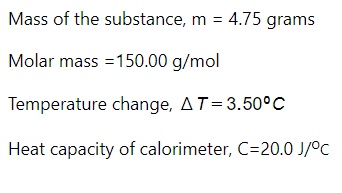Given Information: NA = 6.022 x1023 w--PAV AE= q +w 9cal = CcalAT q= CAT -grxn- 9cal q= mCgAT M= mol/L milli (m): 1x103 base units kilo (k): 1x10 base units Calculate the molar enthalpy of reaction (AH) in J/mol if 4.75 grams of a substance (formula mass of 150.00 g/mol) is burned in a calorimeter, and the temperature rises by 3.50°C. The heat capacity of the calorimeter is 20.0 1/°c.
Thermochemistry
Thermochemistry can be considered as a branch of thermodynamics that deals with the connections between warmth, work, and various types of energy, formed because of different synthetic and actual cycles. Thermochemistry describes the energy changes that occur as a result of reactions or chemical changes in a substance.
Exergonic Reaction
The term exergonic is derived from the Greek word in which ‘ergon’ means work and exergonic means ‘work outside’. Exergonic reactions releases work energy. Exergonic reactions are different from exothermic reactions, the one that releases only heat energy during the course of the reaction. So, exothermic reaction is one type of exergonic reaction. Exergonic reaction releases work energy in different forms like heat, light or sound. For example, a glow stick releases light making that an exergonic reaction and not an exothermic reaction since no heat is released. Even endothermic reactions at very high temperature are exergonic.


Step by step
Solved in 2 steps with 2 images









